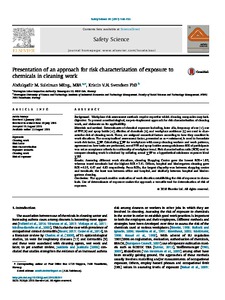Presentation of an approach for risk characterization of exposure to chemicals in cleaning work

Suleiman, Abdulqadir M. ; Svendsen, Kristin V.H.
2017
91
January
148-153
chemicals ; cleaning ; exposure assessment ; risk assessment
Risk assessment and risk management
http://dx.doi.org/10.1016/j.ssci.2016.08.011
English
Bibliogr.
"BackgroundWorkplace risk assessment methods require expertise which cleaning companies may lack.ObjectiveTo present a methodological, easy-to-implement approach for risk characterisation of cleaning work, and elaborate on its applicability.Materials and methodDeterminants of chemical exposure including, inter alia, frequency of use (?), use of PPE (?) and spray bottle (?), dilution of chemicals (?), and workplace ambience (?) are used to characterise risk of cleaning work. These, are assigned numerical factors according to how they manifest in work situations. The conceptualised assessment factor, presented as ? = ????????? is used to formulate work risk factor, ?RF. Calculating ?RF for workplaces with many cleaning workers and work patterns, agreement on how tasks are performed, use of PPE and spray bottles among minimum 60% of participants was set as acceptance criteria for uniformity of workplace trend. Risk characterisation ratio (RCR) used to compare cleaning work is obtained by collating actual ?RF to a hypothetical minimum exposure ideal ?RF.ResultsAssessing different work situations, cleaning Shopping Centre gave the lowest RCR = 1.65, whereas travel terminals had the highest RCR = 7.41. Offices, hospital and kindergarten cleaning gave RCR = 4.05, 4.47 and 4.82 respectively. From RCRs, the largest disparity was between shopping centre and terminals; the least was between office and hospital, and similarly between hospital and kindergartens cleaning.ConclusionThe approach enables evaluation of work situation establishing the risk of exposure to chemicals. Use of determinants of exposure makes the approach a versatile tool for determination of risk of exposure."
Digital
The ETUI is co-funded by the European Union. Views and opinions expressed are however those of the author(s) only and do not necessarily reflect those of the European Union or the ETUI.